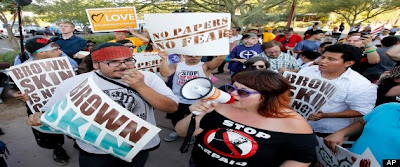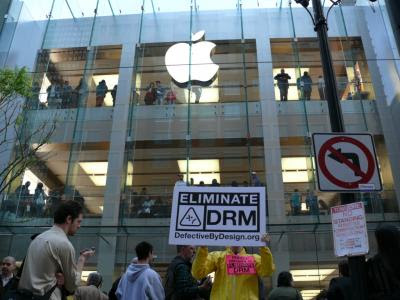 |
| Image Source: huffingtonpost.com |
WASHINGTON -- In 1994, Thomas Saenz was just a few years out of Yale Law School when one of the most high-profile immigration law fights erupted in California. Lawmakers were pushing Proposition 187, a ballot initiative that would have prohibited undocumented individuals from using public services; his state became the epicenter of the country's battles over immigration rights.
A first-year staff attorney at the Mexican American Legal Defense and Education Fund and a third-generation Mexican-American, Saenz was handed a tough task. The initiative enjoyed overwhelming support from Republicans, including Gov. Pete Wilson, leaving opponents with few political options. So they chose a legal one.
After the referendum's passage by voters in November 1994, the legal defense fund took to the courts to try to stall its enactment, with Saenz presenting written and oral arguments on numerous occasions. The tactic worked: Implementation of the new law was delayed, and in 1999 when Democrat Gov. Gray Davis took office, he stopped defending it in court, meaning the law did not survive.
Nearly 13 years later, the lessons from Prop 187 still resonate, and Saenz again finds himself hunkered down in the legal trenches. Having returned to the legal defense fund as its president after a stint serving as counsel to Los Angeles Mayor Antonio Villaraigosa, he, along with a cadre of like-minded groups and lawyers, is playing a critical behind-the-scenes role in trying to stop Arizona's controversial immigration law, SB 1070.
"A lot of people can be hurt by these kinds of proposals, so you really have to stop them and hold them off," said Saenz, who at 46 still retains a youthful look despite a sprinkling of gray hair.
So far, efforts to thwart the Arizona law's enactment have met with mixed success. While the Supreme Court last week struck down parts of the Arizona law, it upheld its centerpiece, the "papers, please" provision that lets police check the immigration status of anyone suspected of being an unauthorized immigrant.
But the court could have upheld the law in its entirety (as many expected) and the fact that it left the door open for a striking down of the "papers, please" provision has been hailed as a breakthrough by many immigration reform advocates.
The court's ruling also paves the way for additional legal challenges.
Initially the Mexican American Legal Defense and Education Fund, the American Civil Liberties Union, the National Association for the Advancement of Colored People and others had sued Arizona on the grounds that the law pre-empted federal authority and could lead to racial profiling and diminished rights for day laborers and other immigrants. The Justice Department later sued, and the fact that its challenge went to the Supreme Court is seen by some civil rights advocates as an affirmation that their best chance for progress may come through the courts.
Going the litigation route when other means of political influence fall short is a method that civil rights groups have tapped before. The 1951 filing of the Brown v. Board of Education of Topeka, Kansas case resulted in the ending of segregation in public education and proved a defining moment in the civil rights movement. Over time, legal wins have led to legislative victories, including the passage of the Civil Rights Act of 1964, the Voting Rights Act of 1965 and the Fair Housing Act of 1968.
Ben Jealous, the current president of the NAACP, sees similarities between previous civil rights struggles and the obstacles now faced by those seeking immigration reform. He likened the “show me your papers” provision of Arizona's law to the days when free blacks had to carry documents when traveling across states or else face the threat of being forced back into slavery. With this history in mind, he deemed it “a fairly easy call” to join the lawsuit against SB 1070.
"That took the issue to the 75 yard line,” Jealous said of last week's Supreme Court ruling. “We’ve got to get across the goal line, keep on litigating until an end to racial profiling is achieved as well. You just keep on pushing."
Many Latino immigration rights advocacy groups are following that advice.
The National Day Laborer Organizing Network, for example, worked with the Mexican American legal defense fund to challenge ordinances in Redondo Beach and Costa Mesa, Calif., and other places that barred workers from soliciting employment on streets or highways. The Redondo Beach ordinance was ruled unconstitutional in September by the 9th Circuit Court of Appeals, on the grounds that it violated the right to freedom of speech.
The legal fights are "like putting one's finger in the dam," said the National Day Laborer Organizing Network's legal director, Chris Newman, stressing the need for a broader political movement to ultimately resolve problems facing immigrant communities.
"From our perspective, litigation is best when used as a tool to advance organizing," Newman said. "In the end what's happening is Arizona is about political power."
Sometimes lawsuits have been used as an organizing tool as Hispanic immigration advocacy groups try to sway public opinion. Omar Jadwat, a senior staff attorney for the ACLU’s Immigrants Rights Project, said that more state legislatures are slowly coming to the conclusion that laws like SB 1070 are not the answer to immigration concerns. But it’s important to ensure that “scapegoating and dividing of communities and racial profiling aren’t allowed to happen in the meantime,” he said.
Karen Tumlin, managing attorney at National Immigration Law Center, said her group felt felt compelled to join the coalition suing the state of Arizona out of concern that SB 1070 would become the first of several dominoes to fall -- that is, states adopting laws that drastically restrict immigrants' rights. Since Arizona Gov. Jan Brewer, a Republican, signed the Arizona law in 2010, a number of states, including Alabama, Georgia and South Carolina, have enacted copycat legislation.
"We're drawing a line in the sand here," Tumlin said. "We will not accept this for our communities."
The coalition is still analyzing last week’s Supreme Court decision to see what implications it could have on the case. The coalition's primary focus for now is to make sure the law does not go into effect but it hopes that a defeat of SB 1070 in court will help galvanize broader political change.
For example, the passage of Proposition 187 marked a major turning point in the politicization of California’s Latino electorate. More than half of the 39 percent of Latinos on the electoral rolls in 2000 said they registered to vote after the ballot initiative passed, according to a survey by the Field Research Corp., a California public opinion research firm.
Opponents of SB 1070 hope the controversy surrounding the law could eventually have the same effect in Arizona.
"If you win in narrow doctrinal theory but you don't change hearts and minds, if you don't change the contours of the debate, you potentially could have a pyrrhic victory," Newman said. "You could always write another statute ... unless you change the political motivation that caused the rights violation in the first place."
To Saenz, California's history provides an example of how immigrant rights activists can change political motivation by showing that laws like Proposition 187 and SB 1070 alienate Latino voters. "Really, in the long term, the solution will be what it was in California," Saenz said. Given time, "the community will change and express its views."
Evan Granowitz attends to clients’ concerns on various facets of civil litigation. Visit this Facebook page for more information about the industry.


.jpg)

